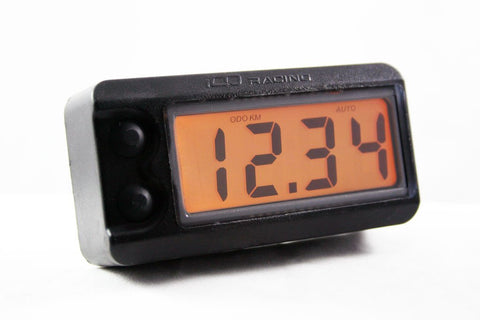What is a Tripmeter?
The ability to measure traveled distance accurately, and correlate it with distances in a roadbook is at the heart of Rally Navigation.
A tripmeter at its most basic is simply an adjustable, highly accurate odometer. More advanced features can include measuring speed, providing compass headings for HP/OP sections, providing a clock, stage timer, hour meter for maintenance scheduling, and displaying waypoint information.
How do they work?
There are two main types of tripmeters:
- Wheel Sensor Driven
Wheel sensor tripmeters rely on a micro switch sensor usually placed near a front wheel hub that is triggered by a magnet usually located on a brake rotor. As the magnet passes over the sensor with each revolution of the wheel, a pulse is registered by the tripmeter. This pulse is multiplied by the conversion factor programmed into the tripmeter, and a distance is displayed to the racer. Wheel sensor tripmeters require very little electricity to operate, and can operate for periods without external power. Wheel sensor tripmeters are usually less expensive.
- GPS Driven
GPS driven tripmeters rely on a GPS antenna to provide course data to the tripmeter. In additional to displaying speed and odometer, GPS driven tripmeters can provide additional functionality like compass (CAP) headings. GPS driven tripmeters do not require the install and routing of a wheel sensor, but will not function without external power. NOTE: Some events such as Dakar or Rebelle restrict the use of GPS devices.
An in-depth discussion of the effective accuracy difference between GPS and Wheel Sensor is here, but for nearly all Rally purposes, we can consider the accuracy between the two to be equal. Nearly all of the (very rare) Tripmeter failures we see are related to cable damage. Both GPS and Wheel Sensor units can be equally reliable with careful install and cable protection.
Since its release in 2017, the ICO MAX series has become the world standard. It’s rare to see a Dakar bike without at least one ICO MAX-2 (Wheel Sensor). The new MAX series has a billet case and 25x65mm “Seven Segment” LCD screen (Similar to a digital clock) with bright orange backlight. The MAX-G has an external cabled GPS Antenna. The ICOs are designed and built in the USA.
The ICO MAX-2 (Wheel Sensor) is $350USD
The ICO MAX-G (GPS) is $450USD

How many do I need?
Most Pro and Factory bikes run 2 tripmeters above the roadbook in addition to the timing and scoring device provided by the Race Organization (RallyComp, Stella, ERTF) mounted below the roadbook. The KTM RFR Factory bike also uses a third tripmeter (an ICO MAX-2) as a dedicated speedometer. This gives the most redundancy, and also allows the rider to see as much information as possible at a glance without having to change modes on any of the devices.
That all said, Organization Timing and Scoring devices (RallyComp, ERTF, Stella) have tripmeter speed, odo, and compass function, and can be used as an additional tripmeter.
In addition, a single GPS tripmeter like the ICO MAX-G does have all three of the needed modes (odo, compass, speed) if you are willing to scroll between the modes as you ride.
In short, having 2 tripmeters (at least one of which is a GPS unit for CAP (compass) function) is the best way to go for competitiveness and safety. A rider can still run many events with a single unit if they are willing to rely on the Org device and/or scroll the modes on their tripmeter, however.
Still have questions? Contact us! We love to talk Rally!

